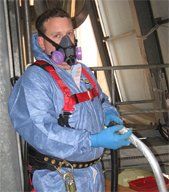Safety Information & Recommended Tips
Meth labs
can be found anywhere. They have been discovered in rural areas, large cities, suburban neighborhoods, small towns, homes, apartments, hotels, restaurants – EVERYWHERE. Some labs are portable and can fit inside a backpack. Labs can be found in all socioeconomic areas. This is a problem of extreme danger. When the chemicals used in manufacturing Meth are combined, they can ignite, causing explosions, fires, and the release of toxic fumes. The cooking and smoking process create poisonous gasses and hazardous byproducts. These materials are occasionally dumped outdoors, which can be detrimental to the surrounding environment and deadly to wildlife. The liquids are often disposed of in bathtubs, toilets, and sinks, typically leaving stains, and the harmful residue can potentially remain for years. Vapors caused by Meth manufacturing can easily permeate plaster, wood, and other porous materials. Methamphetamine and its toxic byproducts, including those vapors, can cause irreparable harm to the environment and drinking water and can be extremely harmful to humans and animals. It is important to know how to spot a Meth lab and to know what to do if you suspect you have encountered one.
What To Look For
DISCLAIMER: Seeing only one of these signs does not mean that the property you are looking at is a Meth-affected property, but do be wary. If you see 4 or more of these aspects and have sufficient belief and evidence outside of these aspects, CALL 911. As we have discussed above, Meth is a very dangerous substance and can be very harmful if you don’t know how to deal with it.
- Unusual and strong odors like ammonia, ether, acetone, or other chemicals.
- Windows blacked out or covered by aluminum foil, plywood, sheets, blankets, etc.
- Unusual behavior of tenants often denying access to the dwelling. Renters who pay their landlords in cash. (Most drug dealers trade exclusively in cash.)
- Lots of traffic - people coming and going at unusual times, especially at night.
- Excessive trash including large amounts of antifreeze containers, lantern fuel cans, Heet (gas line antifreeze) containers, red or rust-stained coffee filters, drain cleaner, blister-packs from cold medicines, matchbooks, lithium batteries, empty salt containers, microwave ovens, camp stoves, and duct tape.
- Glass containers like mason jars and lab beakers.
- Propane tanks with corroded valves
- Unusually excessive or aggressive protection of the area surrounding the residence (video cameras, alarm systems, guard dogs, reinforced doors, electrified fencing).
- Persons exiting the structure to smoke
Everyday Items Used To Manufacture Meth:
- Anhydrous ammonia commonly stored in propane tanks (corroded or blue-green tinged valves)
- Red phosphorous
- Over-the-counter cold medicines such as Sudafed in the blister packs
- Lithium batteries, matchbooks, camp fuel, heat
- Rock salt, iodine, peroxide, alcohol (there are over 160 chemicals that can be used in the manufacturing process)
- Coffee filters, funnels, plastic tubing, mason jars
- Camp stoves, microwaves
What To Do If You Suspect A Meth Lab:
- Call law enforcement immediately - 911
- Do not attempt to handle the situation or alert the suspects of your suspicions.
- Do not enter the property or touch anything associated with the lab. Breathing the fumes or handling any items related to a Meth production lab can be harmful and even cause death. Drug labs should be entered only by trained professionals with the proper protective equipment, including suits, boots, gloves, and respirators.
Call Crystal Clean Decontamination™ LLC. At 303-884-5489. We can advise you on what to do next. Only a handful of our inquiries and decontaminations are officially and bureaucratically reported drug labs. For information on how to spot a Meth lab, click here

